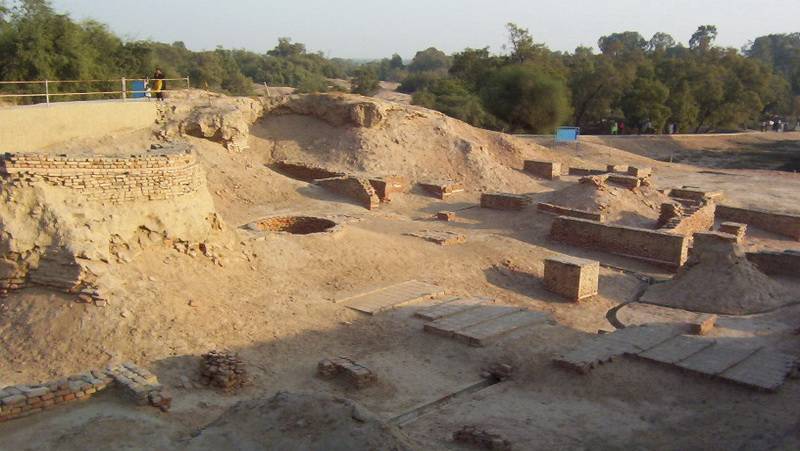The excavation at the Harrapan site Rakhighari, near Haryana, has unearthed four complete human skeletons thought to date back some 5,000 years, as well as discovering a new burial mound, which makes the site the largest known Harrapan urban centre excavated. The discovery has reignited interest across South Asia in the ancient Indus Valley civilisation, also known as the Harrapan civilisation, which along with the Egyptian civilisation in the Nile delta and the Sumer civilisation in Mesopotamia is considered to be the ‘cradle of civilisation’ – the first places which displayed advanced agriculture, planned urban centres and a common script. Despite its exalted status in human history, the Indus Valley Civilisations remains the least explored of the three – and in case of several Pakistani sites, the least preserved.
Wider South Asia – including Pakistan, India, Bangladesh and parts of Afghanistan and Iran – is littered with ancient sites and artefacts. These lands are the home to Buddhism and Hinduism, as well as their precursor faiths. Moreover centuries of invasions – from diverse cultures such as Greek, Arab and Mongol – have also left visible marks across the land; especially the lands that make up Pakistan, as these were the bulwark against most invasions from the west. These facts make Pakistan a racial and cultural melting pot, with a unique identity, grounded in one of the world’s oldest civilisations.
It is a shame then, that the majority of Pakistan and most of the government trace their identity to the moment Muhammed Bin Qasim landed in Sindh in 8th century AD, ignoring several millenniums’ worth of history. This is reflected amongst other things in the differential treatment given to heritage sites across Pakistan. Mughal, and early Muslim sites are relatively better preserved than those belonging to other cultures. The Buddhist monasteries in Taxila suffer from extensive rain damage while the famous temple of Kali in Balochistan is in decrepit condition. The most heinous of such oversight is in relation to the Harrapan sites. The sites at Harrapa and Mohenjo-Daro face erosion damage and vandalism, while authorities overlooking the site have allowed construction to encroach on protected land.
Perhaps more culpable than neglect is the fact that the government has not carried any new excavations for decades, nor has it shown any interest in inviting other archaeologists to do so. Who knows how much history remains buried in land, undiscovered? The discovery at Rakhighari prompted Indian scholars to put forward a theory claiming that the Indus Valley civilisation originated in present day India instead of Pakistan. While the matter will be examined further in the coming months, one thing is certain; Pakistan will be able to shed very little light on this question. By forgetting history prior to the Muslim invasion we have allowed India to claim sole propriety over a culture both nations share.
Thursday, November 21, 2024
Cradle Of Civilisation

ECP disqualifies Adil Bazai under Article 63A, declares NA-262 seat vacant
5:36 PM | November 21, 2024
Kazakh deputy FM meets Pakistan's industry minister for cooperation talks
4:16 PM | November 21, 2024
Imran Khan remanded in police custody for five days in New Town case
4:03 PM | November 21, 2024
Former test spinner and umpire Nazir Junior passes away at 78
3:59 PM | November 21, 2024
Suspected Bandit killed in Wazirabad police encounter
3:57 PM | November 21, 2024
-
Hunger crisis to increase in South Sudan, warns UN
-
Hunger crisis to increase in South Sudan, warns UN
-
Pakistan’s judiciary champions climate justice at COP29 in Baku
-
Punjab struggles with persistent smog as Met Office forecast rainfall
-
Punjab residents face escalating smog crisis as pollution levels soar across country
-
Qatar says Hamas 'no longer welcome' in Gulf state
Land of Vigilantes
November 21, 2024
United in Genocide
November 21, 2024
Finally Fighting Back
November 21, 2024
Digital Stagnation
November 20, 2024
Xi’s Red Lines
November 20, 2024
Independent Supreme Court
November 21, 2024
Fat Loss Fantasy
November 21, 2024
Tackle Corruption Within School Boards
November 20, 2024
To Be Opportunistic
November 20, 2024
Democratic Backsliding
November 20, 2024
ePaper - Nawaiwaqt
Nawaiwaqt Group | Copyright © 2024





